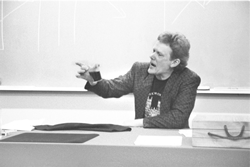High
Wire Artist Petit on First Step to Creativity
by Julie Johnson
Philippe
Petit, the high wire artist famed for walking across a wire stretched
between the twin towers of the World Trade Center, came to Oberlin
to lead workshops on creativity as part of the Emerging Arts Program.
Petit led two workshops this week for professor Linda Wientraub’s
Emerging Arts course and gave an open lecture entitled “The
First Step” on Monday night.
 |
|
How
Does He Do It? “My friends tell me ‘Be
careful!’ when I cross the street, but when I’m
on the wire they are happy.” (photo by Tom Shortliffe)
|
|
Petit, a genius for accomplishing small and large artistic endeavors,
has performed high wire walks across five continents — some
supported and requested by cities and others stealthy surprises
for lucky observers. A few examples include walks between the Palestinian
and Jewish quarters of Jerusalem, Grand Central Station, Notre Dame,
the Eiffel Tower and a walk in Frankfurt, Germany. He is presently
planning a walk across a section of the Grand Canyon. To Petit,
high wire walks are theatrical expressions of art, rather than entertaining
circus acts. “This is a quest for perfection,” Petit said.
“What is beautiful is the path, and what is nice is that the
path has no end.”
It was clear from a young age that Petit was destined to be a child
of the arts. At six, Petit was already juggling in the streets and
told his father, “I want to be a theatrical director!”
A fervent connoisseur of medieval history, Petit learned much of
his trade from old texts. He mentioned a seven page book from the
1800s from which he learned a card trick. Petit kept accumulating
talents, and became a well-rounded street performer, integrating
talents as a magician, mime and tightrope walker.
Petit says that the street was where he got his education, and that
is an important aspect to his methods of learning. “I was expelled
from five different schools by doing magic under my desk,”
Petit said, “Life taught me subjects that are not taught in
school, like lectures on tenacity for the insane, symposiums on
thought provocation, engineering by intuition.”
Monday night’s lecture focused on the principles of creativity
by intuition, though Petit stressed the essential relationship between
spontaneity and rigorous planning. Petit spends years, even decades,
working on a high wire project, and is involved in every step of
the process — from the walk’s conception to the logistical
details of the wire and supporting structures. “I am everywhere
because my life depends on it,” said Petit.
“It’s really moving when a person who does such unbelievable
things with his life can speak in a way to apply it to other people’s
daily lives,” said senior Ryan Miller, who attended Monday’s
lecture. “Because I can’t devote my life to just one thing,
it’s really amazing to see someone direct their lives in such
a specific direction. What I really liked was how, even though what
he does seems so clownish, he takes it so seriously, sees it as
theater. Probably most people who watch him just see it as some
spectacle, not necessarily art.”
When asked why he has chosen such a dangerous profession, Petit
admits his art may seem like that of a madman. “It’s very
strange, I love life. I am not at all death wishing, but I am not
afraid of death. I would not say ‘I give up’— that’s
why I am so careful. I am so happy with what I do,” Petit said.
Petit’s 1974 walk between the World Trade Center’s twin
towers took nine years from conception to actualization. Petit would
sneak up to the roof daily to sit and plan. “I disguised myself
as an engineer or a journalist…to get in,” said Petit.
“My job was to daydream at that time, knowing it was impossible.”
“Nixon was resigning and in some papers I was page one, he
page two. It was a performance not just with New York, but with
the entire world.”
Petit’s twin towers walk holds a poignant symbolism after last
week’s tragedy. “I love my illegal walks. I loved the
World Trade Center. I couldn’t talk when I heard about the
tragedy,” Petit said. Petit suggested that in an ideal world,
the country would rebuild the towers and let him walk across as
a symbol of resilience in the face of destruction. “We should
not stop creating,” Petit said. “We have to continue to
look up even as we are walking on the ashes of disaster.”
|




